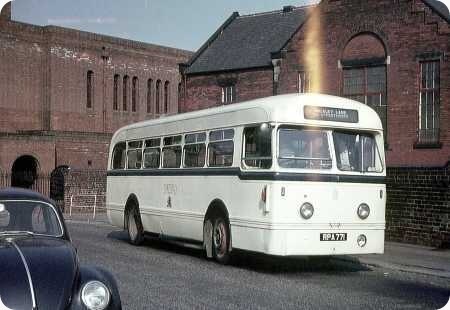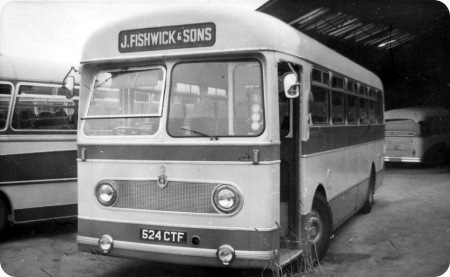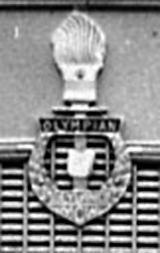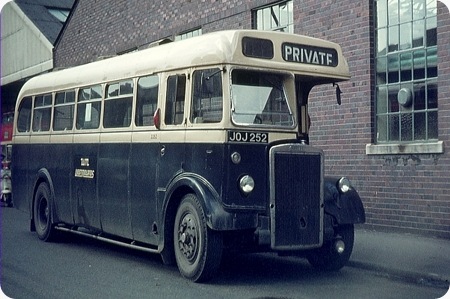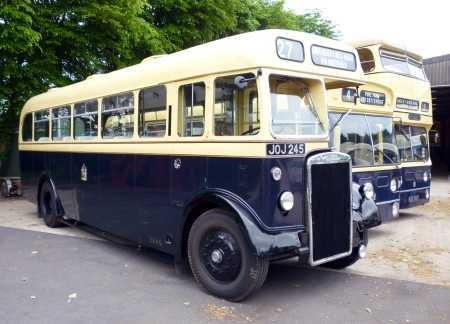Sheffield Corporation – Leyland Olympic – RPA 771 – 211
Sheffield Corporation
1952
Leyland Olympic HR44
Weymann B44F
Sheffield bought three early Leyland Olympics in 1951 and followed up two years later by the acquisition of this former Demonstrator. It put in a good service life lasting until 1968 when it was sold to Dodd, (Dealer) in Dromera, Ireland. I wonder if it found a buyer or whether it was scrapped? The bus was originally fleet number 211 being renumbered as shown in the 1967 scheme. This photo was taken on 10th June 1967 at the Hillsborough terminus of the 31 Lower Walkley service which was characterised by narrow streets and steep hills.
Photograph and Copy contributed by Ian Wild
25/04/12 – 05:16
I think I remember these in Sheffield: were they the "integral" versions? Some had an Olympic torch badge on the front, I think. They always seemed high-floored (the opposite to what you could expect) and a bit awkward, but presumably suited the route.
Joe
25/04/12 – 05:17
From 1952 until 1956 I lived on the 31 and travelled on these and the back loader Royal Tigers. This is now a terminus for Stagecoach 52 and is also close to where the Malin Bridge branch leaves the main Supertram line to Middlewood.
David Oldfield
25/04/12 – 08:36
Can anyone tell me what size engine were in these Olympics please. I believe the King Alfred Olympic that is currently being restored and nearing completion was rescued from Ireland. I always thought it was a great shame that one of the Halifax Corporation Worldmasters were not saved for preservation especially fleet No1 – KCP 1 what a great registration number! Two of these vehicles ended up in Ireland with Keneallys coaches.
Richard McAllister
25/04/12 – 09:20
The Olympic was the integral predecessor of the Royal Tiger and shared all the same mechanical units – including the 9.8 litre 0.600. They were high floored and probably awkward – but what else would you expect of an early underfloor vehicle? [The open backed Royal Tigers 222/223 were even more awkward.] As for suiting the route, they only suited it for the operator (dimensions and power for a hilly route) certainly not passenger friendly – especially the aged and infirm. Passenger comfort only became a priority from about ten years later when technology and new designs allowed it.
David Oldfield
25/04/12 – 15:27
Yes- they looked like the ugly sisters in the sixties- especially as you say, the Tiger rear loaders. My point is that I assume in an integral bus you are not fixing a body to a one-size-fits-all chassis and could therefore make some allowance for the passengers… or what’s the point (I think that was the problem- there wasn’t one…?… or was weight reduced?) What were the advantages? You were presumably stuck with the basics of the original body for good?
Joe
25/04/12 – 16:33
Modern integral buses are monocoque, just like cars (which also used to have separate bodies/chassis)and, I think, are almost universal nowadays. You’re right, though, Joe, you picks your body length, they bold on all the mechanicals and you’re stuck with it. London Transport’s tram/trolleybus department, separate from its bus department, created integral trolleybuses around 1937, using several companies to build them, including Brush and Leyland. Strange how long it took for this system to begin to become popular, around the time when Olympics were coming off the lines and said trolleybuses were starting to go to the scrapyard!
Chris Hebbron
25/04/12 – 16:37
Leeds single deck requirements were few in post war years indeed they only bought 10 saloons in the fifties but managed to have three chassis types! These were 5 AEC Reliances 3 Leyland Tiger Cub and a pair of Guy Arab LUFs. All had the same body layout which was B34C + 14 crush load standees in a central vestibule opposite the doors. Like Sheffield’s Royal Tigers the steps were vertiginous and deep most off putting for intending passengers. Getting a push chair aboard was a major logistical exercise! The overall body shape was common to all ten but the final pair of Reliances had a more upright profile. They were mainly confined to two routes one of which passed under a low bridge and another which crossed the canal on abridge with weight restrictions.
Chris Hough
25/04/12 – 17:39
Joe, the intention with all early integrals was to save weight – it was impossible to be passenger friendly until the dawn of the rear-engined bus. Unfortunately, all of the major manufacturers found that the weight saving margin was no where near enough and that, quite the opposite, there were major weaknesses – often around suspension mountings. This was certainly true of the Bristol LS which transformed after five years into the almost identical MW chassis. Similar problems beset the AEC Monocoach which died out in favour of the Reliance. The other problem was that British operators preferred, and still do, to choose their own bodywork – cf the Leyland National of later years. Ironically the change from LS to MW and Monocaoch to Reliance were not so evident as the separate body chosen for the separate chassis tended to be identical, in all other respects, with the earlier integral body. [Come to think of it, many moved over to the Royal Tiger with identical Weymann coachwork!]
David Oldfield
25/04/12 – 17:39
Just wait until someone discovers the advantages of "demountable" bus bodies: bodies can be changed or swapped on a "chassis", giving greater flexibility, more opportunities for upgrading, and cutting service times. Why didn’t anyone think of that before?
Joe
26/04/12 – 06:14
1904 is beyond most people’s memories, Joe.
David Oldfield
26/04/12 – 11:39
There were demountable bodies in the early twenties, Joe, although they were usually in the form of exchangeable lorry/charabanc bodies. It never carried over, though into exchangeable bus bodies, to my knowledge, at least, not in a big way.
Chris Hebbron
26/04/12 – 11:40
Nice one, Joe. However, the idea of demountable bodies does actually go back a long way. Maidstone and District started in 1911 with three Gilford chassis; these had bus bodies during the day which were changed for lorry bodies at night. I believe the lorries were used to carry vegetables to and from Covent Garden. I’m sure there are plenty of other examples elsewhere, too.
No doubt David is right when he talks about weight saving being a factor in the development of integrals, but I rather suspect that other motives in early post-war attempts were to use parts from pre-war chassis, and to generate extra work for the maker. Beadle, of course, were prominent in this field; others included Harrington and Saunders-Roe.
Roy Burke
27/04/12 – 07:22
I remember this bus from my student days and wondered why there was an odd one with a Surrey registration.
It would have demonstrated for Weymann, who were based at Addlestone. Evidently it was never fitted with standard Sheffield blinds. I never rode on the 31 although I had "digs" near Crookes on the 52 route.
The open-platform Royal Tigers used on the same route looked odd and a bit reminiscent of Edinburgh; I think the local Inspectorate had something to say about the arrangement.
Geoff Kerr
27/04/12 – 08:39
Yes, Geoff, there were responsible for the fitting of the odd looking emergency door at the rear – NEXT to an open rear platform!
Roy, what said is true but Weymann and Park Royal never did a Beadle with second-hand parts.
I type this about my home town of Sheffield from two miles up the hill from Addlestone. Funny old world.
David Oldfield
27/04/12 – 09:34
And I, a Surrey-ite, who long ago moved away, still visit my brother in Ottershaw, just across the M25 from you, David. Incidentally, whatever happened to Weymann’s works? I assume it no longer exists.
Chris Hebbron
27/04/12 – 10:35
Well, for the initiated Chris, I’m typing IN Ottershaw itself! [Funny AND small world.] Until I retired a year or two back, I passed it on the way to school – St George’s College – but ever since the turn of the millennium it has been a deserted, speculative, office block awaiting tenants. All glass and security guards with nothing to do! You must know that Addlestone Garage is a gated development (yes, in Addlestone) and the Co-op long ago made way for Tescos.
David Oldfield
28/04/12 – 08:48
A remarkable coincidence, indeed, David!
Pardon my irony when I say that the changes you mention pass, nowadays, as progress. The supreme one, though, is the gated development!
My abiding memory of Ottershaw is the Aldershot & District Dennis Lances passing by to and from Woking and the occasional ride on them as part of my journey from Portsmouth by rail.
Lovely buses. The whole area was a hotchpotch between London Transport and A&D and you could never be sure what company’s bus would pop out from some side turning.
Also, Ottershaw was the last/first telephone exchange in the London Area and I would use a callbox there to make calls to my London relatives at local call rates. Some would say miserly, I call it ‘being careful’! Happy days.
Chris Hebbron
28/04/12 – 14:47
You could have been a Yorkshireman!!!
David Oldfield
20/07/12 – 15:48
One of the benefits of the open platforms was that passengers could "hop off" whilst the vehicle was approaching the stop, preventing the driver having to do steep hill starts. The conductor would be ready with his finger on the bell to let the driver know he did not have to stop. No H&S in those days, conductors encouraged it. I got very good at jumping off buses coming up Haymarket to turn right up high street on my way home from school. I believe that is why London kept the Routemasters so long, people could hop on & off where they liked, speeding journey times.
Andy Fisher
21/07/12 – 07:38
Is that Haymarket, Sheffield, Andy?
David Oldfield
21/07/12 – 12:10
While the subject of bell-ringing comes up (not campanology, silly!) I recall, post-war, the LT conductors giving three rings to signify to the driver that the bus was full up and he could ignore queues at future stops until some passengers got off. Standing was unlimited post-war, I seem to recall, or the limit was ignored, then became eight, and eventually five. Admittedly, buses engines/brakes are more powerful (the latter more vicious, too!) but it was amazing how much more fluid passenger movement was then. They moved around the vehicle, up and down stairs and got on/off the platform effortlessly ‘whilst the bus was in motion’, moved around the vehicle. Despite my advanced years, I’m still fit, yet wouldn’t do those things now, apart from moving to the exit before the bus stops and that with great care and a tight grip on stanchions!
I used to love travelling on worn-out LT/ST’s, overloaded beyond belief. Juddering clutches, slow acceleration in waves, the vehicle leaning alarmingly round any corner. Despite all that so-called gentleness, an aunt of mine failed to stop me, as a baby, from falling out of her arms when she was climbing the open staircase of an LT and being caught by a surprised man, unharmed, so they say! Some of you might regret this, boring you with such tales!
Chris Hebbron
23/09/17 – 07:02
Regarding the bells, I was a conductor in Sheffield, with a good driver you became a good team and could trust each other, so not just quick bells for passengers getting off but when the last passenger had one foot on the platform and one hand on the pole it was ding ding, if in doubt assist them on with their spare arm. Yes for us three bells was full up and a shower of bells was emergency stop. We didn’t like the passengers using the bell because it sometimes confused things, we preferred the request of next stop please verbally.
Pete
Quick links to the - Comments Page - Contact Page - Home Page
